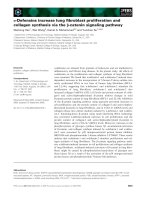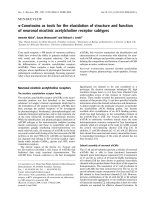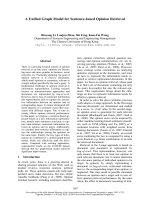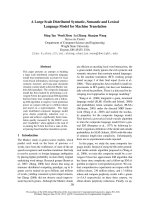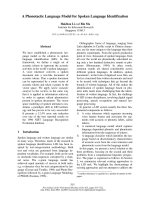Báo cáo khoa học: " a Movie Dialogue Corpus for Research and Development" potx
Bạn đang xem bản rút gọn của tài liệu. Xem và tải ngay bản đầy đủ của tài liệu tại đây (102.25 KB, 5 trang )
Proceedings of the 50th Annual Meeting of the Association for Computational Linguistics, pages 203–207,
Jeju, Republic of Korea, 8-14 July 2012.
c
2012 Association for Computational Linguistics
Movie-DiC: a Movie Dialogue Corpus for Research and Development
Rafael E. Banchs
Human Language Technology
Institute for Infocomm Research
Singapore 138632
Abstract
This paper describes Movie-DiC a Movie
Dialogue Corpus recently collected for re-
search and development purposes. The col-
lected dataset comprises 132,229 dialogues
containing a total of 764,146 turns that
have been extracted from 753 movies. De-
tails on how the data collection has been
created and how it is structured are pro-
vided along with its main statistics and cha-
racteristics.
1 Introduction
Data driven applications have proliferated in Com-
putational Linguistics during the last decade. Seve-
ral factors, such as the availability of more power-
ful computers, an almost unlimited storage ca-
pacity, the availability of large volumes of data in
digital format, as well as the recent advances in
machine learning theory, have significantly con-
tributed to such a proliferation.
Among the many applications that have benefi-
ted from this data-driven boom, probably the most
representative examples are: information retrieval
(Qin et al., 2008), machine translation (Brown et
al., 1993), question answering (Molla-Aliod and
Vicedo, 2010) and dialogue systems (Rieser and
Lemon, 2011).
In the specific case of dialogue systems, data
acquisition can impose some challenges depending
on the specific domain and task the dialogue sys-
tem is targeted for. In some specific domains, in
which human-human dialogue applications already
exists, data collection is generally straight forward,
while in some other cases, data design and collec-
tion can constitute a complex problem (Williams
and Young, 2003; Zue, 2007; Misu et al., 2009).
Depending on the objective being pursued, dia-
logue systems can be grouped into two major cate-
gories: task-oriented and chat-oriented systems. In
the first case, the system is required to help the
user to accomplish a specific goal or objective
(Busemann et al., 1997; Stallard, 2000). In the se-
cond case, the system objective is mainly entertain-
ment oriented. Systems in this category are re-
quired to play, chitchat or just accompany the user
(Weizenbaum, 1966; Wallis, 2010).
In this work, we focus our attention on dialogue
data which is suitable for training chat-oriented
dialogue systems. Different from task-oriented dia-
logue collections (Mann, 2003), instead of being
concentrated on a specific domain or area of
knowledge, the training dataset for a chat-oriented
dialogue system must cover a wide variety of do-
mains, as well as be able to provide a fair represen-
tation of world-knowledge semantics and prag-
matics (Bunt, 2000). To this end, we have col-
lected dialogues from movie scripts aiming at
constructing a dialogue corpus which should pro-
vide a good sample of domains, styles and world
knowledge, as well as constitute a valuable re-
source for research and development purposes.
The rest of the paper is structured as follows.
Section 2 describes in detail the implemented col-
lection process and the structure of the generated
database. Section 3 presents the main statistics, as
well as the main characteristics of the resulting
corpus. Finally, section 4 presents our conclusions
and future work plans.
203
2 Collecting Dialogues from Movies
As already stated in the introduction, our presented
dialogue corpus has been extracted from movie
scripts. More specifically, scripts freely available
from The Internet Movie Script Data Collection
( />) have been used. In this
section we describe the implemented data collec-
tion process and the data structure finally used for
the generated corpus.
As a first step of the collection construction,
dialogues have to be identified and extracted from
the crawled html files. Three basic types of infor-
mation elements are extracted from the scripts:
speakers, utterances and context.
The utterance and speaker information elements
contain what is said at each dialogue turn and the
corresponding character who says it, respectively.
Context information elements, on the other hand,
contain all additional information/texts appearing
in the scripts, which are typically of narrative
nature and explain what is happening in the scene.
Figure 1 depicts a browser snapshot illustrating
the typical layout of a movie script and the most
common spatial distribution of the aforementioned
information elements.
It is important to mention that a lot of different
variants to the format presented in Figure 1 can be
actually encountered in The Internet Movie Script
Data Collection. Because of this, our parsing al-
gorithms had to be revised and adjusted several
times in order to achieve a reasonable level of
robustness that allowed for processing the largest
possible amount of movie scripts.
Another important problem was the identifica-
tion of dialogue boundaries. Some heuristics were
implemented by taking into account the size and
number of context elements between speaker turns.
A post-processing step was also implemented to
either filter out or amend some of the most com-
mon parsing errors occurring during the extraction
phase. Some of these errors include: corrupted for-
mats, turn continuations, notes inserted within the
turn, misspelling of speaker names, etc.
In addition to this, a semi-automatic process was
still necessary to filter out movie scripts exhibiting
extremely different layouts or invalid file formats.
Approximately, 17% of the movie scripts crawled
from The Internet Movie Script Data Collection
had to be discarded. From a total of 911 crawled
scripts, only 753 were successfully processed.
Figure 1: Typical layout of a movie script
The extracted information was finally organized
in dialogical units, in which the information regar-
ding turn sequences inside each dialogue, as well
as dialogue sequences within each movie script
was preserved. Figure 2 illustrates an example of
the XML representation for one of the dialogues
extracted from Who Framed Roger Rabbit.
<dialogue id="47" n_utterances="4">
<speaker>VALIANT</speaker>
<context></context>
<utterance>You shot Roger.</utterance>
<speaker>JESSICA RABBIT</speaker>
<context>Jessica moves the box aside and
tugs on the rabbit ears. The rabbit head pops
off. Underneath is a Weasle. In his hand is the
Colt .45 Buntline.</context>
<utterance>That's not Roger. It's one of
Doom's men. He killed R.K. Maroon.</utterance>
<speaker>VALIANT</speaker>
<context></context>
<utterance>Lady, I guess I had you pegged
wrong.</utterance>
<speaker>JESSICA RABBIT</speaker>
<context>As they run down the
alley </context>
<utterance>Don't worry, you're not the
first. We better get out of here.</utterance>
</dialogue>
Figure 2: An example of a dialogue unit
204
3 Movie Dialogue Corpus Statistics
In this section we present the main statistics of the
resulting dialogue corpus and study some of its
more important properties. The final dialogue col-
lection was the result of successfully processing
753 movie scripts. Table 1 summarizes the main
statistics of the resulting dialogue collection.
Total number of scripts collected 911
Total number of scripts processed 753
Total number of dialogues 132,229
Total number of speaker turns 764,146
Average amount of dialogues per movie 175.60
Average amount of turns per movie 1,014.80
Average amount of turns per dialogue 5.78
Table 1: Main statistics of the collected movie
dialogue dataset
Movies were mainly crawled from the action,
crime, drama and thriller genres. However, as each
movie commonly belongs to more than one single
genre, much more genres are actually represented
in the dataset. Table 2 summarizes the distribution
of movies by genre (notice that, as most of the
movies belong to more than one genre, the total
summation of percentages exceeds 100%).
Genre Movies Percentage
Action 258 34.26
Adventure 133 17.66
Animation 22 2.92
Comedy 149 19.79
Crime 163 21.65
Drama 456 60.56
Family 31 4.12
Fantasy 82 10.89
Horror 104 13.81
Musical 18 2.39
Mystery 95 12.62
Romance 123 16.33
Sci-Fi 129 17.13
Thriller 329 43.69
War 25 3.32
Western 11 1.46
Table 2: Distribution of movies per genre
The first characteristic of the corpus to be ana-
lyzed is the distribution of dialogues per movie.
This distribution is shown in Figure 3. As seen
from the figure, the distribution of dialogues per
movie is clearly symmetric around its mean value
of 175 dialogues per movie. For most of the mo-
vies in the collection, a number of dialogues ran-
ging from about 100 to 250 were extracted.
Figure 3: Distribution of dialogues per movie
The second property of the corpus to be studied
is the distribution of turns per dialogue. This distri-
bution is shown in Figure 4. As seen from the
figure, this distribution approximates a power law
behavior, with a large number of very short dia-
logues (about 50K two-turn dialogues) and a small
amount of long dialogues (only six dialogues with
more than 200 turns). The median of the distribu-
tion is 5.63 turns per dialogue.
Figure 4: Distribution of turns per dialogue
The third property of the corpus to be described
is the distribution of number of speakers per dia-
205
logue. This distribution is shown in Figure 5. As
seen from the bar-plot depicted in the figure, the
largest proportion of dialogues (around 60K) in-
volves two speakers. The second largest proportion
of “dialogues” (about 35K) involves only a single
speaker, which means that this subset of the data
collection is actually composed by monologues or
single speaker interventions. The third and fourth
larger proportions are those involving three and
four speakers, respectively.
Figure 5: Distribution of number of speakers per
dialogue
Finally, in Figure 6, we present a cross-plot be-
tween the number of dialogues and the number of
turns within each movie script.
Figure 6: Cross-plot between the number of
dialogues and turns within each movie script
As seen from the cross-plot, an average movie
has between 150 and 200 dialogues comprising
between 1000 and 1200 turns in total. The cross-
plot also reveals some interesting extreme cases in
the data collection.
For instance, movies with few dialogues but ma-
ny turns are located towards the upper-left corner
of the figure. In this zone we can find movies as:
Happy Birthday Wanda June, Hannah and Her
Sisters and All About Eve. In the lower-left corner
of the figure we can find movies with few dia-
logues and few turns, as for instance: 1492 Con-
quest of Paradise and The Cooler.
In the right side of the figure we find the lots-of-
dialogues region. There we can find movies with
lots of very short dialogues (lower-right corner),
such as Jimmy and Judy and Walking Tall; or mo-
vies with lots of dialogues and turns (upper-right
corner), such as The Curious Case of Benjamin
Button and Jennifer’s Body.
4 Conclusions and Future Work
In this paper, we have described Movie-DiC a
Movie Dialogue Corpus that has been collected for
research and development purposes. The data col-
lection comprises 132,229 dialogues containing a
total of 764,146 turns/utterances that have been
extracted from 753 movies. Details on how the
data collection has been created and how the
corpus is structured were provided along with the
main statistics and characteristics of the corpus.
Although strictly speaking, and by its particular
nature, Movie-DiC does not constitute a corpus of
real human-to-human dialogues, it does constitute
an excellent dataset for studying the semantic and
pragmatic aspects of human communication within
a wide variety of contexts, scenarios, styles and
socio-cultural settings.
Specific technologies and applications that can
exploit a resource like this include, but are not res-
tricted to: example-based chat bots (Banchs and Li,
2012), question answering systems, discourse and
pragmatics analysis, narrative vs. colloquial style
classification, genre classification, etc.
As future work, we intend to expand the current
size of the collection from 0.7K to 2K movies, as
well as to improve some of our parsing and post-
processing algorithms for reducing the amount of
noise still present in the collection and enhance the
quality of the current version of the dataset.
206
Acknowledgments
The author would like to thank the Institute for
Infocomm Research for its support and permission
to publish this work.
References
Banchs R E, Li H (2012) IRIS: a chat-oriented dialogue
system based on the vector space model. In Procee-
dings of the 50
th
Annual Meeting of the ACL, demo
session.
Brown P, Della Pietra S, Della Pietra V, Mercer R
(1993) The mathematics of statistical machine trans-
lation: parameter estimation. Computational Linguis-
tics 19(2):263-311.
Bunt H (ed) (2000) Abduction, belief, and context in
dialogue: studies in computational pragmatics. J.
Benjamins.
Busemann S, Declerck T, Diagne A, Dini L, Klein J,
Schmeier S (1997) Natural language dialogue service
for appointment scheduling agents. In Proceedings of
the 5
th
Conference on Applied Natural Language Pro-
cessing, pp 25-32.
Mann W (2003) The Dialogue Diversity Corpus. Acces-
sed online on 16 March 2012 from: http://www-
bcf.usc.edu/~billmann/diversity/DDivers-site.htm
Misu T, Ohtake K, Hori C, Kashioka H, Nakamura S
(2009) Annotating communicative function and se-
mantic content in dialogue act for construction of
consulting dialogue systems. In Proceedings of the
Int. Conf. of Spoken Language Processing
Molla-Aliod D, Vicedo J (2010) Question answering. In
Indurkhya and Damerau (eds) Handbook of Natural
Language Processing, pp 485-510. Chapman & Hall.
Qin T, Liu T, Zhang X, Wang D, Xiong W, Li H (2008)
Learning to rank relational objects and its application
to Web search. In Proceedings of the 17
th Interna-
tional Conference on World Wide Web, pp 407-416.
Rieser V, Lemon O (2011) Reinforcement learning for
adaptive dialogue systems: a data-driven methodolo-
gy for dialogue management and natural language
generation. Springer.
Stallard D (2000) Talk’n’travel: a conversational system
for air travel planning. In Proceedings of the 6
th
Conference on Applied Natural Language Proces-
sing, pp 68-75.
Wallis P (2010) A robot in the kitchen. In Proceedings
of the ACL 2010 Workshop on Companionable Dia-
logue Systems, pp 25-30.
Weizenbaum J (1966) ELIZA – A computer program
for the study of natural language communication be-
tween man and machine. Communications of the
ACM 9(1):36-45.
Williams J, Young S (2003) Using Wizard-of-Oz
simulations to bootstrap Reinforcement-Learning-
based dialog management systems. In Proceedings of
the 4
th
SIGDIAL Workshop on Discourse and Dia-
logue.
Zue V (2007) On organic interfaces. In Proceedings of
the International Conference of Spoken Language
Processing.
207

